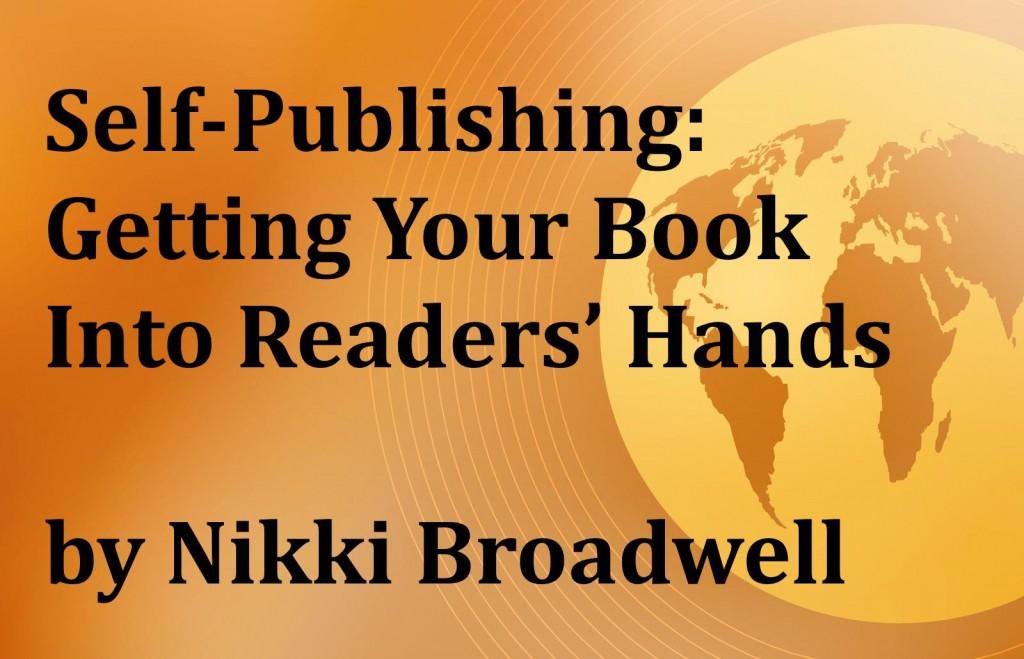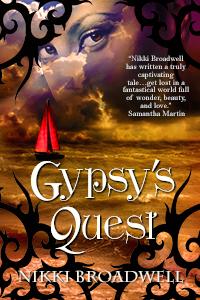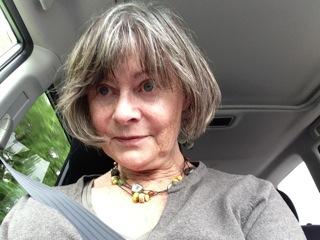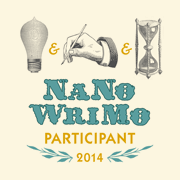Self-Publishing: Getting Your Book Into Readers’ Hands by Nikki Broadwell
Last weekend, as I attended a short retreat, I meant to focus on the speaker and the topic. Instead, I found myself planning the murder in my National Novel Writing Month mystery. I took this as a sign I was on the right track with my life—writing a mystery, that is. Not plotting murder!
This week’s tip comes from author and self-publisher Nikki Broadwell. She lays out for us what she did to figure out how to publish and distribute her books—reminding us that writing, publishing, and marketing your book is truly a process! And don’t forget to check out her first paragraph—she’s giving away her first book today and tomorrow only! (And for the rest of the month, you can get it for a reduced price.)
Happy Writing! Rochelle, the Write Now! Coach
 First of all, thank you to Rochelle Melander for giving me this opportunity!
First of all, thank you to Rochelle Melander for giving me this opportunity!
 The electronic version of the first book of my Gypsy series, Gypsy’s Quest, will be free on Amazon the first two days of this blog post (November 11-12, 2014). And for the rest of the month of November both Gypsy’s Quest and Gypsy’s Return will be .99 in preparation for the release of Book 3, Gypsy’s Secret, which should arrive on Amazon in mid-December.
The electronic version of the first book of my Gypsy series, Gypsy’s Quest, will be free on Amazon the first two days of this blog post (November 11-12, 2014). And for the rest of the month of November both Gypsy’s Quest and Gypsy’s Return will be .99 in preparation for the release of Book 3, Gypsy’s Secret, which should arrive on Amazon in mid-December.
How I got started writing books
I’ve been writing full time for a little over twelve years now. My original plan was to write a sort of memoir about my parents’ life together. This fictionalized story, which is now 400 pages long, has been shelved. I began my first fantasy trilogy as a way to relieve the emotional stress of the memoir but what happened next was an utter surprise.
This fun story took off, and I seriously felt that someone else was writing it. By the time it was finished I had enough material for three books and so I divided it into a trilogy and rewrote a lot of it. After having two editors go through it, I sent it out to over 60 different agents, getting back nearly as many rejections. After a couple of years of this I gave up, deciding that I didn’t have enough time to wait around. And besides, I reasoned, if they did decide to pick it up, they would want to change it and it would take at least two years before it saw the light of day!
I’ve self-published six books since then and am about to release the seventh.
How I self published my books. After a lot of research by both my husband and myself, we chose CreateSpace as the best self-publishing option. We’d read good things, they were connected with Amazon, and their interface was the most straightforward by far. At first I had them do everything, from designing the cover, to formatting both the paperback and the kindle version. In the early days I didn’t know any better. Since then I’ve found a formatter, a cover designer and have saved myself oodles of money. Now when I send in the properly sized spine, I pay nothing for the privilege of having CreateSpace put it all together. All I pay for is my ISBN. My formatter Rik Hall sends me the e-version as well as the paperback PDF, and so it’s a simple process to set it up.
And then I learned about distribution. But there is one important point that I didn’t know. CreateSpace lists expanded distribution through Ingram, an option self-publishers can select once their book is up on the site. Ingram is one of the biggest wholesalers and as such has a great reputation. Unfortunately, there’s a problem. One of my book buyers told me he’d happily order my books, saving me the hassle of paying for them and having them shipped to me and then shipping them to him to be put on consignment. Bear with me on this next bit because I’m still sifting through it, but from what I’ve gleaned so far, the discount offered to bookstores through CreateSpace expanded distribution is not industry standard and on top of that, the POD versions cannot be returned. This poses a serious problem for bookstores.
For some reason my first two books came up on the computer at the small bookstore where my friend tried to order them. But the third did not. This is not explained by CreateSpace or by anyone else that I’ve spoken with.
And so I began to dig. First, I called Createspace and found that they could not or would not change the discount offered to bookstores. I then perused blogs that compared Createspace and Ingram publishing services. And from my reading it did sound as though Ingram was the better choice for print. I e-mailed back and forth with one man who had blogged about this and his recommendations was to do e-books through Createspace and the print books with Ingram.
The move to Ingram. I decided to move some of my newer titles to Ingram. After all how hard could it be, considering the books were already published? After spending $49 for each title and an extra $10 each for redoing the files, I was told I would need to hire a designer. For some reason, one of my titles made it through this process. It had the same formatter and the same cover designer. The only difference was that I had purchased the ISBN directly through Bowker instead of opting for the $10 version offered on CreateSpace. (There’s a free option as well) On the other two titles, I replaced the Createspace ISBN’s with new ones, another outlay of $27 for each title.
I know all of this sounds impossibly complicated and I hope it makes some sense to those of you starting out. What I have now learned is that Ingram has several self-publishing options, and they are NOT created equally. Apparently, in order to get their true expanded distribution one has to publish through Ingram Publishing instead of IngramSpark or Lightning Source. But when I contacted them I was sent back to IngramSpark. So now I have one paperback book listed with Ingram and I doubt very much that the bother of getting it there has done anything for me. I also paid $60 to promote this title. Has this helped? I have no idea.
Ingram’s interface is not as easy as CreateSpace, nor is the ability to contact them. My recommendation for the new author coming into the marketplace is to do your homework and weigh your options. Will you mostly be selling e-books or is it important to have your books listed on the computer when someone searches for them in a bookstore? With all the marketing decisions and everything else that goes into it, self-publishing is not for the faint-hearted. But, for me, it’s been both easy and inexpensive, a step up from the gatekeepers who refuse to even look at one’s work.
As self-publishers, we are stuck with this distribution problem until someone comes up with a better way. This Shewrites article goes one step further to explain it.
Your turn: What worked for you?
 About the author. Nikki was already the mother of two girls when she graduated from Sonoma State University with a degree in Art. After running two successful businesses—creating greeting cards and silk painted scarves and wallhangings—Nikki began writing books. Nikki now lives in Tucson, Arizona with her husband of over thirty years, a standard poodle, Buddha, and Eesa, the cat. She is currently finishing up the third book of a time-traveling trilogy, Gypsy’s Secret. When not writing, Nikki travels, does yoga, hikes, and gardens and watches the bird and animal life that abound in the desert.
About the author. Nikki was already the mother of two girls when she graduated from Sonoma State University with a degree in Art. After running two successful businesses—creating greeting cards and silk painted scarves and wallhangings—Nikki began writing books. Nikki now lives in Tucson, Arizona with her husband of over thirty years, a standard poodle, Buddha, and Eesa, the cat. She is currently finishing up the third book of a time-traveling trilogy, Gypsy’s Secret. When not writing, Nikki travels, does yoga, hikes, and gardens and watches the bird and animal life that abound in the desert.
Connect with Nikki online
http://niksblog-authorinprogress.blogspot.com
https://twitter.com/nikkibroadwell










Those problems with Ingram make me think BookBaby was a good choice for me! I haven’t had any difficulties with them, though I haven’t done print books yet, but they do both print and eformat, and don’t give preference to either, as far as I can see. They distribute to every store I know of and several I’d never heard of, in several countries.
Thanks for sharing this info. I learn so much from the experiences of other writers, and I really appreciate it.